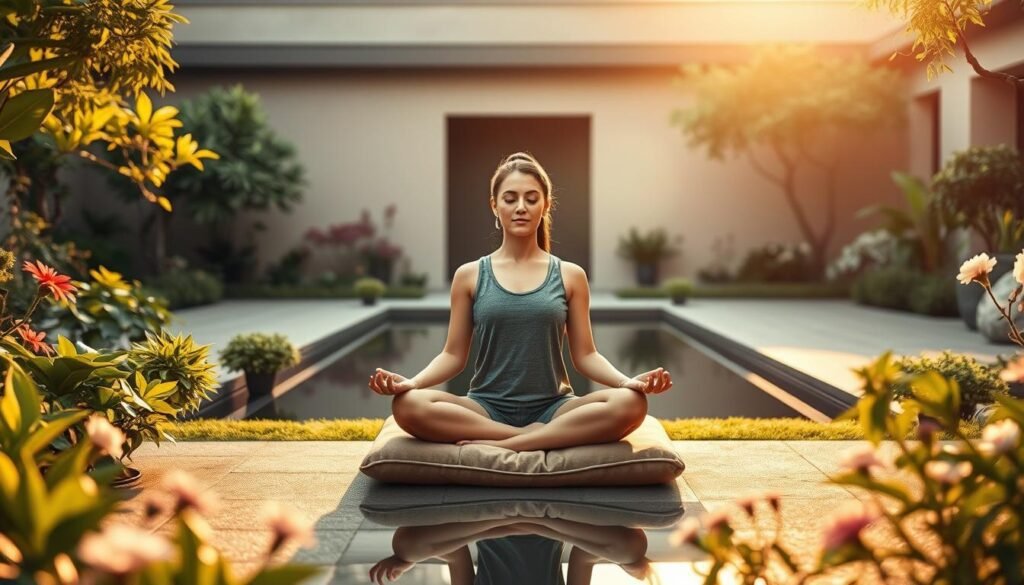Your 10-Minute AI-Guided Mindfulness Break
Busy schedules don’t have to block inner peace. Imagine carving out just 10 minutes a day to recharge your mind. This guide blends time-tested techniques with smart tech to help you build a meditation habit that sticks—no experience required.
Modern life bombards us with distractions, making traditional meditation feel overwhelming. That’s where AI-driven tools shine. They adapt to your pace, offering real-time feedback to sharpen focus and deepen relaxation. Think of it as a personal coach in your pocket.
We’ll walk through science-backed methods to quiet mental chatter and boost emotional resilience. You’ll learn how to start small, track progress, and customize sessions for your lifestyle. Whether you’re a beginner or revisiting mindfulness, this approach removes guesswork.
Key Takeaways
- Fits into even the busiest schedules with short, effective sessions
- Merges ancient meditation principles with adaptive AI technology
- Overcomes common hurdles like wandering thoughts and time constraints
- Requires no prior experience—start fresh today
- Delivers both instant calm and lasting mental clarity
Introduction to Mindfulness and Its Benefits
In a world of distractions, mindfulness anchors us to the present. This practice involves observing thoughts and feelings without criticism—like watching clouds pass without chasing them. Jon Kabat-Zinn’s seven core attitudes, including patience and acceptance, form its foundation. These principles teach us to meet experiences with curiosity rather than resistance.

Understanding the Core Concepts
Mindfulness isn’t about emptying the mind—it’s noticing mental patterns without getting tangled in them. Research from the American Psychological Association shows it strengthens focus and reduces stress by 35% in regular practitioners. By fostering cognitive flexibility, it helps people adapt to challenges instead of reacting impulsively.
Mental and Physical Health Advantages
Regular practice lowers cortisol levels, improving sleep and immune function. Studies link it to a 40% decrease in anxiety symptoms and sharper working memory. Physically, it slows heart rates during stressful moments and eases chronic pain. Best of all, it works across cultures and beliefs—no spirituality required.
Many assume mindfulness demands hours of silence. In reality, even brief moments of intentional awareness during daily tasks build resilience. It’s not about perfection but progress, creating space between stimuli and responses for wiser choices.
The History and Evolution of Mindfulness Practices
Mindfulness isn’t a modern invention—it’s a timeless tool shaped by centuries of human wisdom. Long before apps and guided sessions, cultures worldwide cultivated awareness through rituals, texts, and daily habits. This rich heritage laid the groundwork for today’s science-backed approaches.

Ancient Origins and Cultural Influences
Early Buddhist scriptures from 300 B.C. detailed meditation techniques still used today. Chinese philosopher Daozi later wove mindfulness into Daoist teachings, urging followers to “flow like water” in daily life. Abrahamic traditions also embraced similar principles—Jewish contemplative prayer, Islamic dhikr remembrance, and Christian centering practices all foster present-moment focus.
These methods weren’t confined to temples or monasteries. Farmers used breath awareness during harvests, while artisans practiced focus while crafting. Mindfulness became a bridge between spiritual growth and practical living across continents.
Modern Adaptations and Scientific Validation
Dr. Jon Kabat-Zinn revolutionized the practice in 1979 by creating Mindfulness-Based Stress Reduction (MBSR). His eight-week program stripped away religious elements, making techniques accessible for hospitals and schools. Research soon followed: MRI scans now show how meditation thickens brain regions linked to emotional control.
Today’s AI-driven apps continue this evolution. They adapt ancient wisdom to hectic schedules, offering personalized guidance that earlier practitioners could only dream of. As neuroscience confirms what sages taught millennia ago, mindfulness solidifies its role in global wellness culture.
Your 10-Minute AI-Guided Mindfulness Break: A Step-by-Step Guide
Starting a meditation routine begins with clarity of purpose. Before diving into sessions, take two minutes to ask: “Why does this matter to me?” Jot down answers like stress relief or better sleep. This simple act creates a roadmap for your journey.
Setting Your Intention and Identifying Goals
Effective intentions are specific and achievable. Instead of “be calmer,” try “notice three breaths before reacting to emails.” Research shows concrete goals boost success rates by 60%. Start with five-minute sessions—small wins build confidence.
| Traditional Approach | AI-Guided Method | Key Advantage |
|---|---|---|
| Fixed session lengths | Adapts to your schedule | Saves time |
| Generic instructions | Personalized cues | Deepens focus |
| Manual progress tracking | Automatic analytics | Boosts motivation |
How the AI-Guided Process Supports Your Practice
Smart tools detect wandering thoughts through voice analysis, gently guiding you back to the present moment. One user reported: “The soft chime reminds me to refocus without feeling judged.” Apps adjust session lengths based on your heart rate patterns, making each minute count.
New to meditation? AI breaks techniques into bite-sized steps. Try the 5-2-7 method: inhale for five counts, hold for two, exhale for seven. This rhythm helps calm the mind faster than traditional counting.
Integrating Mindfulness into Your Daily Routine
Consistency transforms mindfulness from an activity to a lifestyle. Small, intentional actions create lasting change—even five focused minutes day can rewire stress responses over time. The secret lies in weaving awareness into existing patterns rather than overhauling schedules.

Establishing a Consistent Practice Space
Designate a corner for your practice, even if it’s temporary. A folded blanket or chair by a window works. Add sensory anchors: lavender oil for relaxation, or soft lighting to signal “focus time.” Research shows consistent environments boost habit formation by 40%.
Simple Strategies for a Daily Mindfulness Habit
Pair sessions with existing routines. Try breath awareness while coffee brews, or body scans before bedtime. One teacher suggests: “Anchor your practice to something you never miss—like brushing teeth.”
| Time of Day | Benefit | Duration Tip |
|---|---|---|
| Morning | Sets calm tone | 3 deep breaths before rising |
| Midday | Resets focus | 2-minute posture check |
| Evening | Promotes rest | 7-count exhales |
Traveling or pressed for time? Use “micro-moments“: feel your feet grounded while waiting in line, or notice three sounds during commute. These mini-pauses keep neural pathways active between formal sessions.
Mindfulness Exercises to Elevate Your Practice
Transform ordinary moments into opportunities for growth with these adaptable techniques. These methods strengthen focus while teaching your body and mind to work in harmony.

Breathing Meditation and Body Scans
Start with seated breath awareness. Sit upright but relaxed, hands resting comfortably. Close your eyes halfway, noticing air moving through nostrils. Count inhales up to four, then exhales back to one. If thoughts wander, gently return to counting.
For body scans, lie flat with knees bent. Begin at your toes—notice tingling or pressure without judgment. Move slowly upward, pausing at tense areas. Imagine breathing into tight spots. One nurse shares: “Scanning helps me release shoulder tension between shifts.”
Mindful Eating and Walking Techniques
Turn meals into sensory adventures. Choose a raisin or chocolate square. Examine its texture under light. Roll it between fingers before tasting. Let it dissolve slowly, tracking flavor changes. This technique reduces rushed eating by 58% in studies.
Walking meditation works anywhere—even office hallways. Match steps to breath rhythm: three steps inhaling, four exhaling. Feel heels press ground first, then toes. Keep gaze soft ahead, arms loose. Struggling with balance? Try slower paces or touch a wall lightly.
| Exercise | Traditional Approach | AI Enhancement |
|---|---|---|
| Breath Focus | Self-guided timing | Pulse-synced reminders |
| Body Scan | Manual progression | Muscle tension alerts |
| Mindful Walk | Fixed routes | Step rhythm analysis |
Short on time? Try 90-second mini-sessions. AI apps now offer posture checks during breath work and soundscapes that match your walking speed. These tools help maintain consistency when life gets hectic.
Overcoming Common Challenges in Mindfulness Practice
Every mindfulness journey encounters bumps—and that’s perfectly normal. Distractions and doubts don’t mean you’re failing. They’re signs you’re growing. The key lies in working with your experiences rather than against them.
Handling Distracting Thoughts and Emotions
When your thoughts wander during practice, celebrate—you’ve noticed! Gently bring focus back to your breath. A yoga teacher suggests: “Imagine thoughts as passing cars. Watch them go by without hopping in.”
For tough emotions, name the feeling silently—”worry” or “fear.” This creates space between you and the emotion. Research shows labeling reduces amygdala activity by 30%.
Tips for Maintaining Consistency and Patience
Missed a session? Try a 60-second reset: three deep breaths while waiting for coffee. Consistency thrives on flexibility, not perfection. One beginner shares: “I meditate while my pasta boils—multitasking made mindful.”
| Challenge | Strategy | Result |
|---|---|---|
| Wandering thoughts | Whisper “thinking” and focus back breath | Faster refocusing |
| Physical discomfort | Use chair support or walk meditations | Longer sessions |
| Time constraints | Pair with toothbrushing or pet care | Habit stacking |
When resistance hits, recall your “why.” Progress in mindfulness often feels like two steps forward, one step back—that’s how neural pathways form. Celebrate showing up, not just breakthroughs.
Advanced Techniques and Personalization in Mindfulness
Elevating your mindfulness journey involves tailoring tools to fit your lifestyle. Modern approaches blend tradition with innovation, offering fresh ways to deepen awareness while honoring personal preferences.
Smart Tools for Focused Growth
Guided apps now analyze breathing patterns through phone microphones, suggesting techniques based on stress levels. Some platforms create custom soundscapes using local weather data—rain sounds for overthinkers, city noise blends for urban dwellers.
Crafting Your Unique Routine
Night owls thrive with moonlit movement meditations, while early risers prefer sunrise visualization. One teacher notes: “Match practices to energy cycles—stretching with yawns, seated focus after caffeine.” Track what clicks using app journals or voice memos.
Reflection That Sparks Change
Try evening gratitude sessions where you replay three positive moments, noting physical sensations each memory evokes. This dual awareness strengthens neural connections between joy and bodily awareness.
Advanced practice isn’t about complexity—it’s purposeful refinement. Whether through AI-curated nature tracks or personalized mantra loops, your path stays uniquely yours while rooted in timeless wellness principles.
FAQ
How does mindfulness improve mental and physical health?
Mindfulness reduces stress by training the brain to focus on the present moment. Studies show it lowers cortisol levels, improves sleep, and boosts emotional resilience. Physically, it can lower blood pressure and enhance immune function. Even 10 minutes daily strengthens mind-body connections.
Can AI-guided meditation replace traditional mindfulness practices?
Tools like Headspace or Calm use AI to personalize sessions, making mindfulness accessible for beginners. While apps enhance consistency, they complement—not replace—core techniques like breath awareness or body scans. Think of AI as a supportive guide, not a substitute.
What’s the easiest way to start a daily mindfulness habit?
Begin with short, focused sessions. Set a routine—like morning breathwork or mindful coffee sips—and use reminders. Apps like Insight Timer offer 5-minute exercises. Consistency matters more than duration. Pair it with activities you already do, like walking or brushing teeth.
How do I handle distractions during meditation?
Distractions are normal. Acknowledge thoughts without judgment, then gently return focus to your breath or body sensations. Apps like Calm provide ambient sounds to anchor attention. Over time, this “noticing and redirecting” builds mental discipline.
Are body scans or walking meditation better for stress relief?
Both work! Body scans help release tension, while walking meditation combines movement and awareness. Try both: use body scans before bed and mindful walks during breaks. Apps like Ten Percent Happier offer guided versions for each technique.
How can I adapt mindfulness for a busy schedule?
Micro-practices integrate seamlessly. Take three mindful breaths between meetings, eat lunch without screens, or pause to notice sensations during chores. Even 60 seconds of focused attention counts. Tools like Centr app tailor sessions to time constraints.
What role does gratitude play in mindfulness?
Gratitude shifts focus from stress to positivity. Try ending each day by noting three things you’re thankful for. Apps like Happyfeed track gratitude moments. This practice rewires the brain to notice joy, deepening mindfulness’s emotional benefits.
Share this content:




Post Comment